A seemingly straightforward question that I often ask doctors is, “How would you describe your practice?” And, a very common reply is “High-tech—yeah, definitely high-tech.” If I ask to elaborate, I’ll hear, “Well, we have all the latest gizmos and equipment. Patients love it!”
Given that response, I’ll ask, “OK then, how would your patients describe your practice?” Their reply is usually less straightforward, and it sounds something like, “Well, I think they’d view it the same way. But, I’m not really sure.”
No doubt, there is often a disconnect between how we perceive our practice, and how our patients do. Yet, in the final marketing analysis, your patients’ perceptions of your practice count much more than your own.
One key source of this disconnect is demonstrated by the practitioner’s response above. The practitioner’s definition of “high-tech” usually only centers on the technology deployed to take care of their patients. Patients, on the other hand, see diagnostic or treatment technology only as a subset of a high-tech practice. Whether your practice is viewed as high-tech is based on patients’ entire experience, which includes communication, the look and feel of the practice, the appearance and attitude of staff, as well as technology. Remember, that the clinical difference between your corneal topographer and your keratometer is a lot more impressive to you than it is to your patients. To them, the colors on the printout or screen are much more impressive than your viewpoint of the topographer’s ability to measure the cornea in 10,000 points instead of four.
If you want to position yourself as the high-tech practitioner in your market, you should certainly have high-tech equipment. But, there are other things you should also be doing. Let’s discuss the must-have features every high-tech practice should include, and how you can use these attributes to market your high-tech practice.
Corneal topographers are invaluable tools that help eye care practitioners document diagnoses, ensure successful contact lens fittings and communicate with other doctors.
Back to Basics
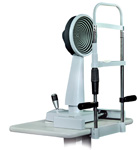
First, elicit ideas from your staff and clearly define and record your vision for your high-tech practice. When doing this, try to answer this question: “If I were a patient, this is what a high-tech practice would mean to me.”
Keep in mind that “high-tech” means different things to different patients. To an elderly patient, the ability to receive an appointment reminder via a text message might qualify as NASA-like technology. A millennial, however, would be more impressed with an up-to-date Facebook page. So, start by clearly defining who your target audience is, and what high-tech means to them. Keep these items in mind as you develop your marketing plan.
Don’t forget the peripherals of what will help contribute to your image and patient experience. As mentioned above, to doctors, technology is usually the hallmark of a high-tech practice. But, an office filled with every latest piece of technology that also has a stained carpet or sloppily dressed staff will certainly not garner all the high-tech patient perception points it could if these other items were tended to. This doesn’t necessarily mean your office needs to be outfitted with chrome and mirrors. But, it certainly needs to be spotless, orderly and have a current look and feel. The sum total of your actual technology, together with a palpable high-tech gestalt is what will help position you as the high-tech practice in your market. Concentrating on just technology is not enough.
Start Within
Once you have these basics in place, you can begin to launch an all-out marketing campaign to claim the high-tech stake in your community. As with most marketing strategies, starting internally is usually best. This phase is typically the least expensive and most productive, and your practice website is a great place to launch this effort. While most of us view websites as external marketing tools—and they can be—don’t forget their value with your current patients, especially their ability to cement your high-tech image in place.
The keys to ensuring your website reinforces your high-tech presence are to make sure it’s not only cosmetically appealing, easy to navigate and user-friendly, but that it’s also functional. Nothing screams “dated technology” than a dusty, poorly designed site that is no more than an electronic brochure. Your website should work for you just like your staff. Web functionality for your current patients should include the ability to schedule appointments, complete paperwork in advance of their visit (e.g., HIPAA notices and history sheets), order products and take surveys.
My favorite affordable online tool for eye care website building and management is www.eyecarepro.net. This web builder allows you to easily and quickly create a great high-tech looking site. With the tools on this site, you can add graphics, flash animations, surveys, etc. Another benefit is that you can easily edit the content yourself and keep it fresh. Having an announcement on your website about an “upcoming” trunk show in May 2003 certainly doesn’t send much of a high-tech, modern image. You can assign a staff member (through various easily set up security features) to edit certain areas of your site but not others.
To date, most appointments still happen on the phone, so to alert patients to the functional areas of your website, have your staff mention it at the close of their appointment. The script can go something like this: “OK then, we’ll see you next Thursday at 3:15 p.m. The next step is to visit our website, so you can complete some forms at your convenience before you arrive. If you give me your email address, I will send that information to you right away.” When it’s presented this way, you gain the extra advantage of collecting your patients’ email addresses and setting the stage for future electronic communication—which reinforces your high-tech presence. For the few patients who don’t have email or those who don’t want to provide it, it’s always best to accommodate your patients’ request, whenever possible. Just make a note in the chart of those patients that they prefer to communicate via phone or snail mail.
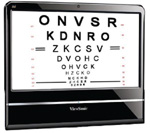
A digital eye chart with an LCD display allows practitioners to control all aspects of the visual acuity examination.
Once patients are in your practice, it’s a great time to show off your actual high-tech equipment offerings. This of course, doesn’t mean acting as a braggart, but rather as an educator and patient advocate. But, you shouldn’t be the only one who possesses this information—make no secret of it, and train your staff about the benefits of all your newest equipment. Then, during patient encounters, make a point to compare your current technology to its replaced predecessors.
You could say, for instance, “This is our new digital retinal camera. Before we bought this, we had to draw pictures by hand. And now, we have a very high-resolution image that we’ll store in your electronic file.” Or, “As you can see, we’ve switched from paper charts to electronic medical records. That means we can keep track of trends and patterns in your eye health more accurately. For example, when I click here, you can see . . .”
The same goes for newer products you might prescribe. “These daily disposable contact lenses are the newest type of lenses we can fit you with, and since we’ve been using them, we no longer have to rely on older, more cumbersome technology lenses.”
Reaching Out to New Patients
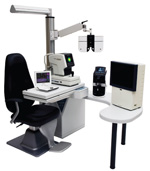
Digital refraction systems, such as the one featured here, have become a mainstay in a modern eye care practice.
For external marketing, make sure the look and feel you choose is in lock step with your desired high-tech result. Unless you have innate design talent, this isn’t the place to try and save money by being a do-it-yourselfer. Hiring a professional graphic designer is money well spent.
To maintain continuity and consistency between your office and your marketing collateral, it’s helpful to have this person visit your office to experience first hand what you’re trying to convey. Subtle graphic elements and design strategies used by professionals can add a lot to your overall message. Good professional designers can decide what these elements should be after experiencing the look and feel of your office for themselves and drawing from their visit.
For this phase, you can use low-tech approaches to drive prospective patients to your high-tech website. Depending on your market and budget, these could include print ads, direct mail, billboards, TV or radio. The long-term goal is to reach new patients who are attracted to your high-tech message. The short-term goal with each marketing piece is to get the patient to contact you via phone, email or by visiting your website. For that reason, it’s often helpful to use a landing page. A landing page is different from your home page—it’s a web address that is not your main website that helps track the results of your marketing effort. For example, if your main website address is www.drjones.com, you can use www.MyContactsRock.com on a particular radio ad. That site will wind up at the drjones.com site, and you’ll know that every time it does, someone responded from your radio ad. You can have various landing pages for different media.
Search engine optimization and social media sites should also be mentioned under this external marketing phase. This is a big topic in and of itself. Make sure that the person who is doing this for you is well educated about your goal of creating a high-tech image, as certain elements of your website need to be “optimized” to achieve that goal. The content of these messages must be focused on the core high-tech image you are trying to convey. Avoid the temptation to be all things to all patients. This isn’t necessarily the time or place to talk about all the insurance plans you accept or the qualifications of your optician. As with all marketing, your audience’s attention span is very short, so be very careful to make sure you stay on point and not waver. Every word and every image should be carefully chosen and placed with the goal of reinforcing your high-tech message. Generally—as with
most messaging—less is more, and clutter, be it in copy or graphics, will only distract from that message.
Employing High-Tech Marketing Strategies
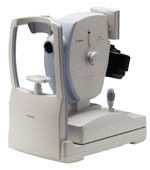
Retinal cameras aid doctors in disease diagnosis and monitoring.
In-office seminars or online webinars are great tools for both current and prospective patients. If you want to showcase the benefits of your new wavefront abberometer or a new type of contact lens you might be fitting, this is an effective, low-cost way to get the message out.
As with everything else that I have mentioned, make sure the content stays focused and has a high-tech flare. If you use a tool such as Microsoft PowerPoint—which is helpful but not essential—make sure that the slides maintain the look and feel of other marketing messages you’ve employed so far. Live seminars or online webinars should be recorded and made available as podcasts on your website or as DVDs that you can send to patients or prospective patients.
Patient testimonials are another great marketing tool to use. These can be used in print or electronically, and the easiest way to get them is simply to ask. The next time patients exclaim about your amazing high-tech ability—“The way you fit my last bifocal contact lens prescription with that machine over there was so cool!”—immediately ask them, “Would you mind sharing that with other patients?” Most patients will be flattered you asked and happy to help. As you are collecting these testimonials, keep them focused on the high-tech aspect you are looking to reinforce.
If your website will support it and patients are amenable to it, short video testimonial vignettes can be very powerful. These can be emailed to prospective patients, placed on your website, run as a loop in your lobby or included on a DVD brochure to send to prospective patients. But, there’s no need to go high-tech or high-cost on the production of these vignettes. In fact, often producing them with a raw, unedited look can be advantageous, as it adds to the presenter’s authenticity.
To measure the effectiveness of your message, it’s a great idea to solicit patient feedback. You can do this through a survey on your website or a handout in the office. Ask patients to describe your practice. Open-ended questions are usually better because they help you cull more useful information than “yes,” “no” or multiple-choice questions. While replies such as, “Friendly and efficient” are nice to receive, if you are aiming for “High-tech,” and you don’t get it, you’ll need to step up your marketing efforts.
High-Tech Must Haves
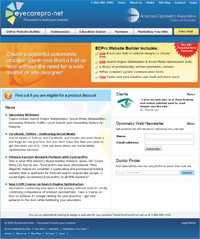
The website building tool at Eyecarepro.net makes it easy for practitioners to create and manage a sophisticated practice site without having to hire a web developer.
The exact technology or technology services you should add to your practice will vary based on your current inventory, budget and goals. That said, there are certain essential tools no high-tech practitioner should do without. These are the things that should be a part of every high-tech practice:
• Website
• Topographer
• Electronic phoroptor/refraction system
• Digital eye chart
• Retinal camera
• Electronic medical records
Go the Extra Mile
Considering the wide range and high cost of high-tech equipment and services that we can offer our to patients, we must make every effort to incorporate this feature of the practice into our marketing efforts. After all, what’s the use of building up your high-tech armamentarium if current and potential patients don’t receive a clear message about your offerings? Investing into the most up-to-date diagnostic tools and websites will only take you so far.
Going the extra mile with effective marketing strategies is essential to cementing your image as the high-tech practitioner in your market and thus, ensuring the economic survival of your practice.
Dr. Gerber is the founder and president of The Power Practice, a practice building and consulting company. He has authored hundreds of articles, and his seminars have been attended by thousands of optometrists worldwide. He can be contacted at [email protected].


